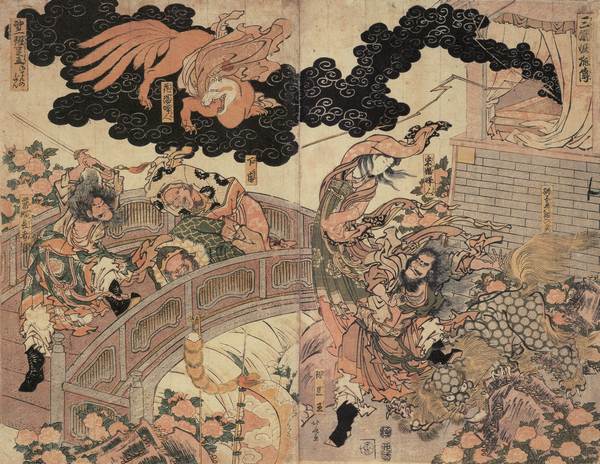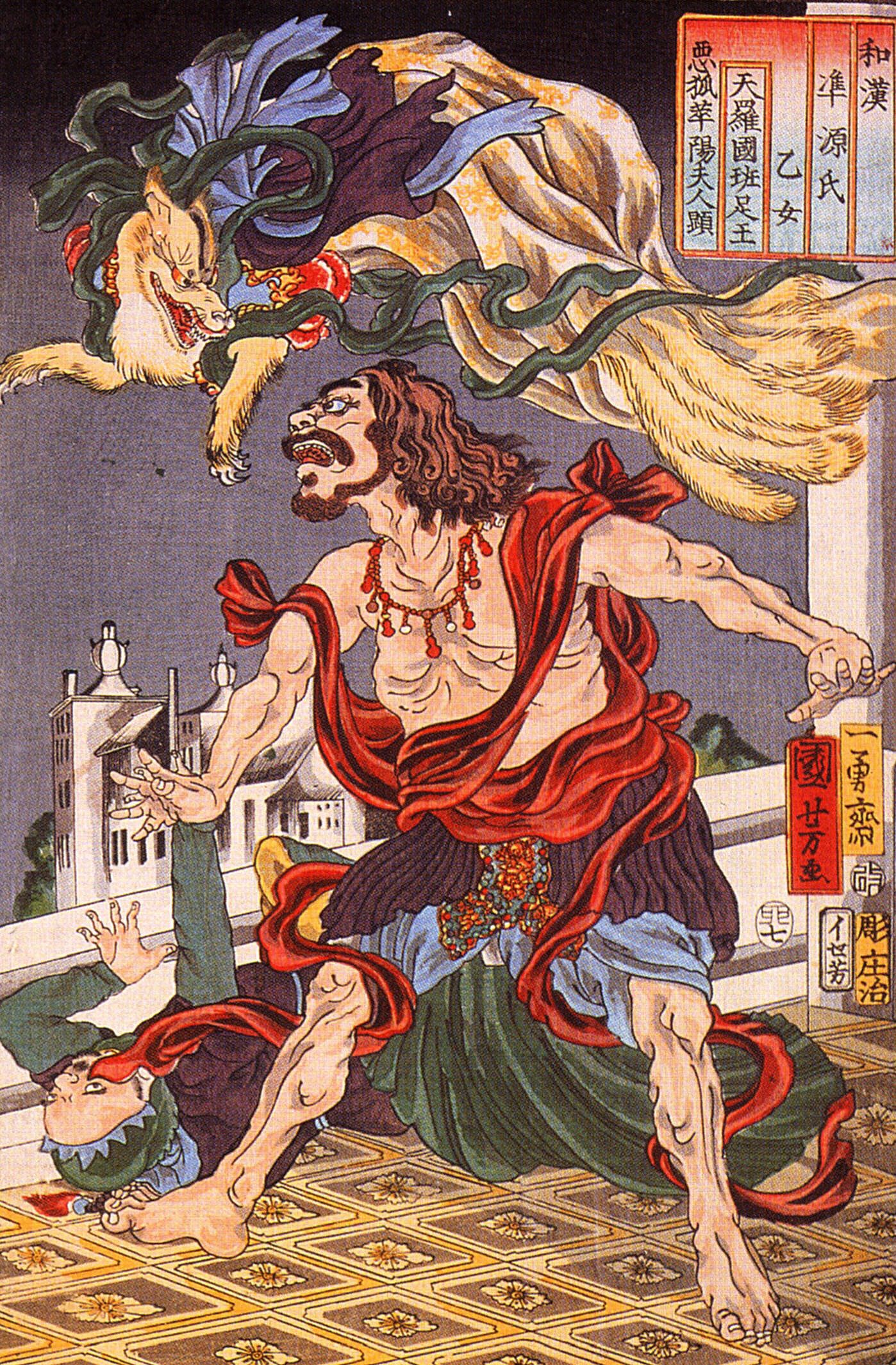|
Kumiho
A kumiho or gumiho (, literally " nine-tailed fox") is a creature that appears in the folktales on East Asia and legends of Korea. It is similar to the Chinese and the Japanese . It can freely transform, among other things, into a beautiful woman often set out to seduce boys, and eat their liver or heart (depending on the legend). There are numerous tales in which the appears, several of which can be found in the encyclopedic ''Compendium of Korean Oral Literature'' (). Mythology The old Chinese text Classic of Mountains and Seas, the earliest record to document the nine-tailed fox, mentioned that the fox with nine tails came from and lived in the country called Qingqiu (靑丘) three hundreds miles east, the term meaning "green hill" interpreted as the country or region of the east and was later historically used to refer to the region of Korea at least since the era during the Three Kingdoms of Korea. However, the name of Gojoseon (called Joseon in the record), the Korean k ... [...More Info...] [...Related Items...] OR: [Wikipedia] [Google] [Baidu] |
The Fox Sister
The Fox Sister is a Korean storyHeinz Insu Fenkl , about the mythical Korean nine-tailed fox demon (''kumiho A kumiho or gumiho (, literally " nine-tailed fox") is a creature that appears in the folktales on East Asia and legends of Korea. It is similar to the Chinese and the Japanese . It can freely transform, among other things, into a beautiful woma ...''). Synopsis A man had three sons and no daughter. He prayed for a daughter, even if she was a fox. His wife gave birth to a daughter, but when the girl was six, one of their cows would die every night. One night, he sent his oldest son to watch. The boy watched and told him that his sister did it, by pulling the liver out of the cow and eating it. His father accused him of having fallen asleep and having a nightmare and threw his son out. Next, the second son was sent to watch over the cows, and nothing happened until the moon was full again. Then, the sister struck, and the second son was also thrown out for report ... [...More Info...] [...Related Items...] OR: [Wikipedia] [Google] [Baidu] |
Fox Spirit
Huli jing () are Chinese mythological creatures usually capable of shapeshifting, who may either be benevolent or malevolent spirits. In Chinese mythology and folklore, the fox spirit takes variant forms with different meanings, powers, characteristics, and shapes, including '' huxian'' (), ''hushen'' (), ''husheng'' (), ''huwang'' (), ''huyao'' (), and ''jiuweihu'' (). Fox spirits and nine-tailed foxes appear frequently in Chinese folklore, literature, and mythology. Depending on the story, the fox spirit's presence may be a good or a bad omen. The motif of nine-tailed foxes from Chinese culture was eventually transmitted and introduced to Japanese and Korean cultures. Descriptions The nine-tailed fox occurs in the ''Shanhaijing'' (''Classic of Mountains and Seas''), compiled from the Warring States period to the Western Han period (circa fourth to circa first century BC). The work states: In chapter 14 of the ''Shanhaijing'', Guo Pu, a scholar of the Eastern Jin dynasty ... [...More Info...] [...Related Items...] OR: [Wikipedia] [Google] [Baidu] |
Vampire
A vampire is a mythical creature that subsists by feeding on the Vitalism, vital essence (generally in the form of blood) of the living. In European folklore, vampires are undead, undead creatures that often visited loved ones and caused mischief or deaths in the neighbourhoods they inhabited while they were alive. They wore shrouds and were often described as bloated and of ruddy or dark countenance, markedly different from today's gaunt, pale vampire which dates from the early 19th century. Vampiric entities have been Vampire folklore by region, recorded in cultures around the world; the term ''vampire'' was popularized in Western Europe after reports of an 18th-century mass hysteria of a pre-existing folk belief in the Balkans and Eastern Europe that in some cases resulted in corpses being staked and people being accused of vampirism. Local variants in Eastern Europe were also known by different names, such as ''shtriga'' in Albanian mythology, Albania, ''vrykolakas'' in G ... [...More Info...] [...Related Items...] OR: [Wikipedia] [Google] [Baidu] |
Female Legendary Creatures
Female (symbol: ♀) is the sex of an organism that produces the large non-motile ova (egg cells), the type of gamete (sex cell) that fuses with the male gamete during sexual reproduction. A female has larger gametes than a male. Females and males are results of the anisogamous reproduction system, wherein gametes are of different sizes, unlike isogamy where they are the same size. The exact mechanism of female gamete evolution remains unknown. In species that have males and females, sex-determination may be based on either sex chromosomes, or environmental conditions. Most female mammals, including female humans, have two X chromosomes. Female characteristics vary between different species with some species having pronounced secondary female sex characteristics, such as the presence of pronounced mammary glands in mammals. In humans, the word ''female'' can also be used to refer to gender in the social sense of gender role or gender identity. Etymology and usage ... [...More Info...] [...Related Items...] OR: [Wikipedia] [Google] [Baidu] |
Ungnyeo
Ungnyeo (, lit. 'bear woman') was a bear that became a woman according to the creation myth of the Korean nation. Story In the tale, a tiger and a bear lived together in a cave and prayed to the divine king Hwanung (the Son of Heaven and son to Hwanin) to be made human. Hwanung heard their prayers and gave them 20 cloves of garlic, a bundle of mugwort and ordered them to stay out of the sunlight and eat only this food for 100 days. Due to hunger, the tiger left the cave after roughly 20 days, but the bear remained inside. After 21 days, she was transformed into a woman, and came to be known as the bear woman Ungnyeo. Ungnyeo was grateful and made offerings to Hwanung. Her lack of a husband drove her to depression, and she began to pray beneath a sacred betula tree () to be blessed with a child. Hwanung heard her prayers and was deeply moved. He took Ungnyeo as his wife and soon after, she gave birth to a son, Dangun, who would go on to found the nation of Korea. Interpreta ... [...More Info...] [...Related Items...] OR: [Wikipedia] [Google] [Baidu] |
Hồ Ly Tinh
Hồ ly tinh ( vi-hantu, 狐狸精, link=no) also known as Hồ tiên (狐仙), Hồ ly (狐狸), Hồ tinh (狐精), Hồ yêu (狐妖), Yêu hồ (妖狐) or Cáo tinh (Chữ Nôm: 𤞺精). Vietnamese nine-tailed fox do not have a specific personality, some stories tell about them harming people but along with them are stories about them helping people. According to a quite famous version, hồ ly tinh are fox that has the ability to cultivate to be able to transform and have magic, if they practice for a hundred years, then they will have three tails and are called ''Yêu hồ'' or ''Tam vĩ yêu hồ'' (Three-tails demon fox), cultivate until after 1000 years, it changed to ''Lục vĩ ma hồ'' (Six-tailed ghost fox). And so on when he reached the realm of 9-tails, ''Cửu vĩ hồ'' or ''Cửu vĩ thiên hồ'' (Nine-tailed celestial fox) they can turn into humans each tail is a life of them. To kill a fox, you must cut off its tail first. Some famous legends In the b ... [...More Info...] [...Related Items...] OR: [Wikipedia] [Google] [Baidu] |
Tamamo-no-Mae
Tamamo-no-Mae (, , also ) is a legendary figure in Japanese mythology. One of the stories explaining the legend comes from Muromachi period genre fiction called '' otogizōshi''. In the otogizōshi Tamamo-no-Mae was a courtesan under the Japanese Emperor Konoe (who reigned from 1142 through 1155). Legends Stories of Tamamo-no-Mae being a legendary fox spirit appear during the Muromachi period as otogizōshi (prose narratives), and were also mentioned by Toriyama Sekien in '' Konjaku Hyakki Shūi''. Edo period folklore then conflated the legend with similar foreign stories about fox spirits corrupting rulers, causing chaos in their territories. In the story told by Hokusai , known simply as Hokusai, was a Japanese ukiyo-e artist of the Edo period, active as a painter and printmaker. He is best known for the woodblock printing in Japan, woodblock print series ''Thirty-Six Views of Mount Fuji'', which includes the ..., formed in the Edo period, the nine-tailed fox fir ... [...More Info...] [...Related Items...] OR: [Wikipedia] [Google] [Baidu] |
Kitsune
In Japanese folklore, , are foxes that possess paranormal abilities that increase as they get older and wiser. According to ''yōkai'' folklore, all foxes have the ability to shapeshift into human form. While some folktales speak of employing this ability to trick others—as foxes in folklore often do—other stories portray them as faithful guardians, friends, and lovers. Foxes and humans lived close together in ancient Japan; this companionship gave rise to legends about the creatures. have become closely associated with Inari, a Shinto or spirit, and serve as its messengers. This role has reinforced the fox's supernatural significance. The more tails a has—they may have as many as nine—the older, wiser, and more powerful it is. Because of their potential power and influence, some people make sacrifices to them as to a deity. Conversely foxes were often seen as " witch animals", especially during the Edo period (1603–1867), and were thought of as goblins who could ... [...More Info...] [...Related Items...] OR: [Wikipedia] [Google] [Baidu] |
Huli Jing
Huli jing () are Chinese mythological creatures usually capable of shapeshifting, who may either be benevolent or malevolent spirits. In Chinese mythology and folklore, the fox spirit takes variant forms with different meanings, powers, characteristics, and shapes, including '' huxian'' (), ''hushen'' (), ''husheng'' (), ''huwang'' (), ''huyao'' (), and ''jiuweihu'' (). Fox spirits and nine-tailed foxes appear frequently in Chinese folklore, literature, and mythology. Depending on the story, the fox spirit's presence may be a good or a bad omen. The motif of nine-tailed foxes from Chinese culture was eventually transmitted and introduced to Japanese and Korean cultures. Descriptions The nine-tailed fox occurs in the '' Shanhaijing'' (''Classic of Mountains and Seas''), compiled from the Warring States period to the Western Han period (circa fourth to circa first century BC). The work states: In chapter 14 of the ''Shanhaijing'', Guo Pu, a scholar of the Eastern Jin dyn ... [...More Info...] [...Related Items...] OR: [Wikipedia] [Google] [Baidu] |
Korean Dragon
Korean dragons are legendary creatures in Korean mythology and folklore. The appearance of the dragon reflects its relation to its East Asian counterparts, including the Chinese dragons. Korean dragons Whereas most dragons in European mythology are linked to the elements of fire and destruction, dragons in Korean mythology are primarily benevolent beings related to water and agriculture, often considered bringers of rain and clouds. Hence, many Korean dragons are said to have resided in rivers, lakes, oceans, or even deep mountain ponds. The symbol of the dragon has been used extensively in Korean culture, both in Korean mythology and ancient Korean art. Ancient texts sometimes mention sentient ''speaking'' dragons, capable of understanding complex emotions such as devotion, kindness, and gratitude. One particular Korean legend speaks of the great King Munmu, who on his deathbed wished to become a " Dragon of the East Sea in order to protect Korea". The Korean dragon is in many ... [...More Info...] [...Related Items...] OR: [Wikipedia] [Google] [Baidu] |



